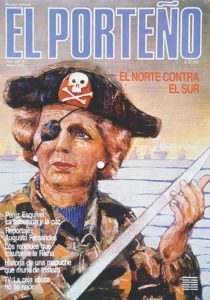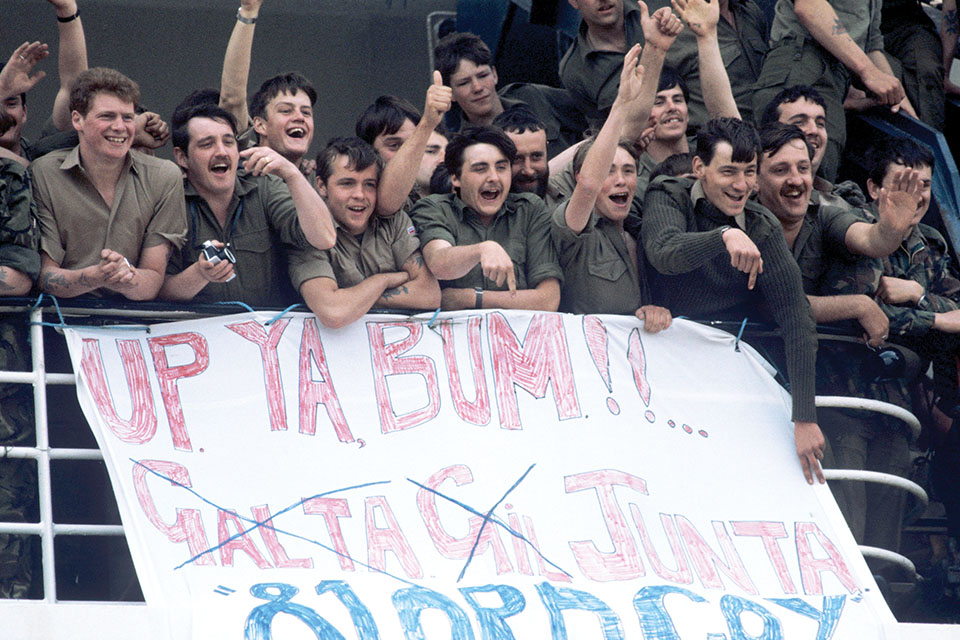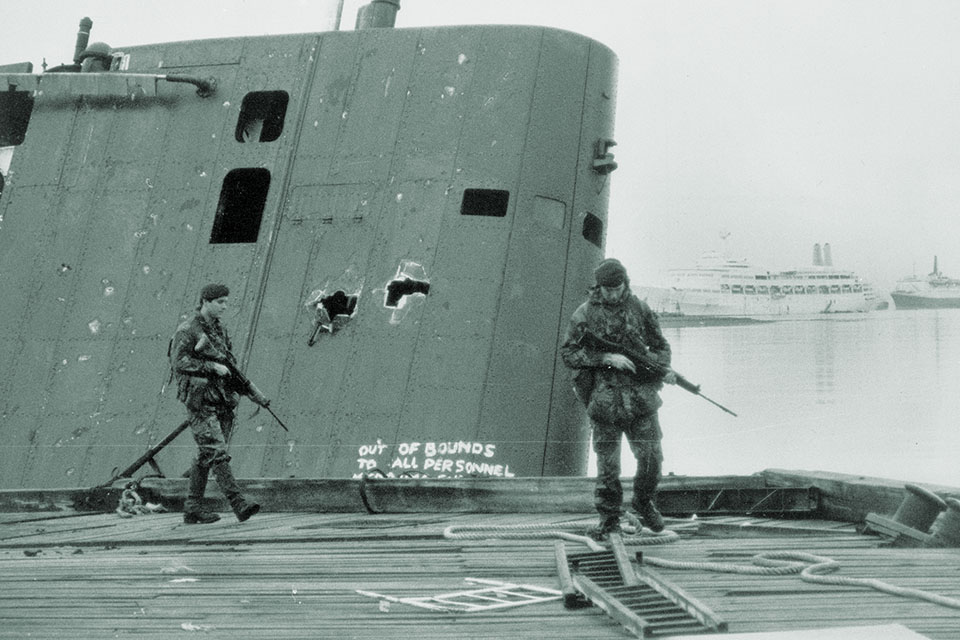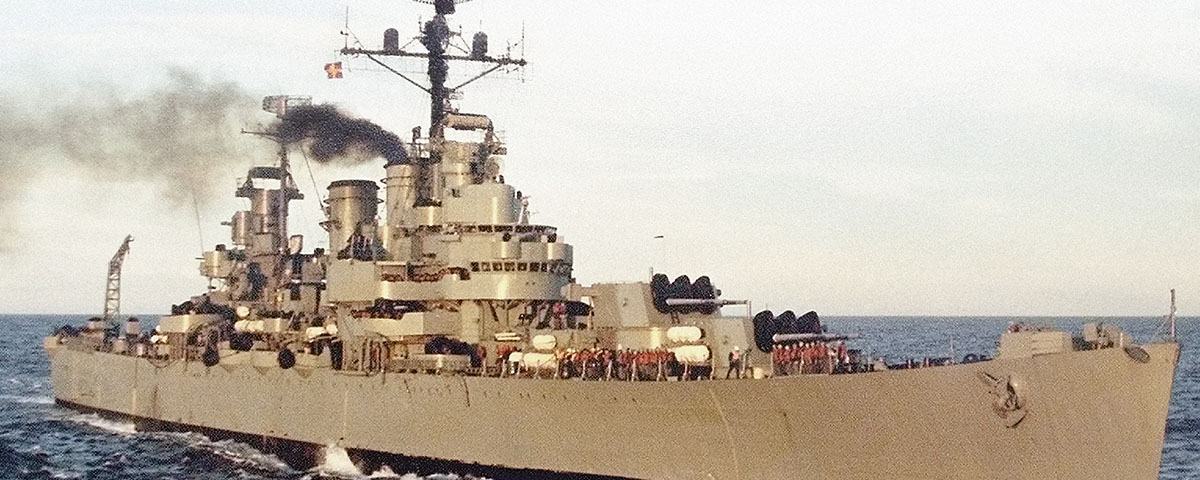While other warships circled each other off the Falkland Islands, a British submarine stalked the Argentine light cruiser
Late on the afternoon of May 2, 1982, the British nuclear-powered fleet submarine HMS Conqueror was running submerged in the South Atlantic Ocean some 230 miles almost due east of Cape Horn. Though designed and built to engage Soviet warships should the Cold War turn hot, that day the sub was stalking prey of a decidedly different kind—a 44-year-old American-built light cruiser that had survived the Dec. 7, 1941, Japanese attack on Pearl Harbor, Hawaii. Commissioned into the U.S. Navy in 1938 as Phoenix, the warship had been struck and sold in 1951, renamed ARA General Belgrano and was the pride of the Argentine navy. Unfortunately for Belgrano and its crew, the cruiser would not survive the coming encounter with Conqueror.

Belgrano and Conqueror were present in the frigid South Atlantic that austral autumn of 1982 thanks to Argentina’s April 2 invasion of the Falkland Islands, a British dependency some 300 miles from the Argentine coast. The nearly 1,000-man invasion force quickly overwhelmed the 100 or so Royal Marines, Royal Navy sailors and local militiamen defending the islands. That same day the British Cabinet ordered the formation of a naval task force to retake the islands. On April 3 Argentine marines captured South Georgia Island, another British dependency more than 800 miles southeast of the Falklands, after a brief firefight with a Royal Marines platoon. Meanwhile, the United Nations Security Council adopted Resolution 502, demanding an immediate cessation of hostilities and the complete withdrawal of Argentine forces from the islands. Also on April 3 British Prime Minister Margaret Thatcher announced the dispatch of the naval task force. Two days later the lead element of the Royal Navy force—which included two aircraft carriers
—departed Portsmouth.
On April 7 the British declared that a Maritime Exclusion Zone (MEZ), centered on the Falklands with a 200-nautical-mile radius, would go into effect on April 12. After that date any Argentine shipping entering the MEZ would be subject to attack without warning. On April 1 the British Admiralty had dispatched the nuclear-powered Swiftsure-class submarines Spartan and Splendid to the South Atlantic. Three days later the Churchill-class Conqueror had departed the Royal Navy submarine base at Faslane, Scotland, also bound for the conflict zone. On April 10 all three submarines received orders to patrol the Falklands and enforce the MEZ.
Through month’s end the opposing nations deployed their forces. On April 17 the Argentine navy sortied its major surface combatants, including Belgrano and the British-built light fleet carrier ARA Veinticinco de Mayo and their escorts. The first naval combat of the war took place on April 25 when Royal Navy Wessex, Wasp and Lynx helicopters badly damaged the Argentine Balao-class submarine Santa Fe off South Georgia Island. The submarine’s captain ordered the sub run aground and the crew to abandon ship. Later that day they and the Argentine marines on South Georgia surrendered to the British.
On April 28 the British government announced that a Total Exclusion Zone—essentially a total blockade of the islands—would go into effect two days later, just as the main British carrier group, designated Task Group 317.8, arrived to enforce the zone. The force comprised the Centaur-class light fleet carrier Hermes (the British flagship), with 12 British Aerospace Sea Harrier FRS.1 fighter-bombers and 18 Westland Sea King helicopters, and the Invincible-class light carrier Invincible, with eight Sea Harriers and 12 Sea Kings. Escorting the carriers were the County-class destroyer Glamorgan and the Type 42 destroyers Sheffield, Coventry and Glasgow. Also in the escort were the Type 21 frigates Arrow, Alacrity and Antelope, the Type 22 frigate Broadsword and the Type 12 frigate Yarmouth. Between them the ships could deploy nearly 40 Sea King helicopters configured for both anti-submarine and assault missions. The various surface combatants were armed with French-built Exocet anti-ship missiles and a variety of anti-aircraft missiles. TG 317.8 was stationed some 30 to 50 nautical miles east of East Falkland Island.
By April 30 Splendid and Spartan were already on station north of the islands, while Conqueror was to the south. The latter had already detected Belgrano and escorts and was maintaining contact.
The British naval mission broke down into four phases. The first was to enforce the TEZ using primarily the submarines, though depending on the target and range, the force could also employ the various aircraft and even detached surface combatants. The second phase was to use surface and air forces to establish sea and air superiority. The third phase was to land Royal Marines and British army ground troops to retake the islands. The final phase was to support the land forces with airpower and naval gunfire while protecting the sea lines of communication.

By April 30 the Argentine navy had completed its own final combat dispositions. Task Force 79 was charged with defending the Falklands and controlled three subordinate task groups. TG 79.1, the carrier battle group, was deployed northwest of the Falklands some 90 nautical miles outside the TEZ and included the flagship Veinticinco de Mayo—with eight U.S.-built Douglas A-4P Skyhawk attack aircraft, six U.S.-built Grumman S-2E Tracker reconnaissance planes and five helicopters—and the escorting destroyers Comodoro Py, Segui, Hércules and Santísima Trinidad. TG 79.4 was some 50 nautical miles west of TG 79.1 and comprised the French-built corvettes Drummond, Guerrico and Granville, each of which carried four Exocet missiles. To the southwest of the islands and also outside the TEZ was TG 79.3, which consisted of Belgrano and the destroyers Piedra Buena and Hipólito Bouchard. Each destroyer carried four Exocets.
On May 1 the British launched a series of attacks against Argentine positions on the islands, including an extremely long-range raid by an Avro Vulcan bomber based on equatorial Ascencion Island against the airport just outside the Falklands’ capital of Stanley—a 6,800-nautical-
mile round-trip. The carrier-based Sea Harriers followed up with strikes on the airport and the landing strip farther west at Goose Green. Meanwhile, the destroyer Glamorgan and frigates Alacrity and Arrow bombarded Argentine defensive positions around Stanley. The Argentines launched more than 50 sorties in hopes of finding and sinking British ships. But only one flight of three mainland-based Israeli-built IAI Dagger fighters found a target: the three ships bombarding Stanley. Though the jets inflicted only minor damage on two of the Royal Navy vessels, the air strike was enough to convince the British ships to break off and rejoin the main task group.
That same day the British detected and backtracked at least two S-2E Tracker recon flights. One of the Sea Harriers backtracking the propeller-driven Argentine planes detected radar emissions from Hércules and also spotted a formation of five unidentified enemy ships before turning back. The British then broke off combat operations for the day and moved south-southeast. Both sides knew roughly where the other was, and each made overnight preparations for the next day’s operations.
The British also had a set of radio intercepts that detailed the enemy’s plans for May 2. The Argentines intended to launch an air strike with A-4s from Veinticinco de Mayo, while the Exocet-armed ships of TG 79.4 would either act in conjunction with the air strike or attack isolated British units. Belgrano and its escorts were to remain south of the islands and continue traveling east, with open orders to exploit any favorable opportunity to attack the British. Those intercepted orders were provided in an intelligence summary to Rear Adm. John Forster “Sandy” Woodward, commander of the British task group.
The prospect of a coordinated Argentine strike was what Woodward most feared. As he reflected in One Hundred Days, his memoir of the war, “Attacked from different directions, by different weapons requiring different responses…[we] could probably shoot down five or six of the incoming Skyhawks—but it would be very bad news if 16 Exocets arrived from the southeast at more or less the same time.”
Aside from the air threat, Woodward was also aware that with a bit of luck either one of the enemy surface groups might get within missile range of his ships. During NATO exercises a year earlier Woodward himself had managed to get one of his destroyers to within Exocet range of an alert and prepared American aircraft carrier. If the Argentines managed something similar, Woodward expected the British “could all be swimming around in the South Atlantic, getting a bit cold and wondering where the hell those 16 Exocets just came from.”
Overnight, the British lost contact with the two Argentine groups to the north, heightening the threat alert from that axis. Though the anticipated air strike didn’t materialize the morning of May 2, Royal Navy forces remained on high alert the rest of the day. Meanwhile, to the south Belgrano and its escorts were approaching the Burdwood Bank. If the Argentine ships were to cross its relative shallows, Conqueror might be unable to follow, might lose track of the enemy and might in turn be detected. Furthermore, the bank was a logical place for the Argentine group to split up. If that happened, Conqueror could lose touch with any one or all three of the enemy ships.
Given the circumstances, Woodward resolved to clip at least “one claw of the pincer” closing on his force. He already had permission to attack the Argentine flagship Veinticinco de Mayo, if able, but the British had not contacted the carrier. On the other hand, Woodward had contact with Belgrano but lacked permission to attack the cruiser. He therefore requested a change in his task force’s rules of engagement (ROE) and that Conqueror be permitted to attack Belgrano. In what British Secretary of State for Defense John Nott later called “one of the easiest decisions of the whole war,” Prime Minister Thatcher and her War Cabinet agreed to change the ROE and ordered Conqueror to sink Belgrano and any other Argentine ship it encountered, even outside the TEZ.
The cruiser and its escorts had changed course at 0811 Zulu time (the military equivalent of Greenwich Mean Time), heading west, in the direction of but not destined for the mainland. Conqueror duly reported its change of direction to London at 1400 Zulu. Then, despite problems with its communications equipment, at 1710 Zulu the British submarine received and acknowledged the new ROE and orders to attack. At the same time Cmdr. Chris Wreford-Brown, Conqueror’s captain, transmitted his intention to strike the enemy.
Over the next two hours Conqueror stalked Belgrano in weather described as “indifferent, sea state 3 or 4, steadily worsening.” During the pursuit Wreford-Brown took his ship up to periscope depth at least five times to get a good track on the target. It was still light, but lingering mist diminished visibility—at one point down to just 2,100 yards. After coming up for another look, the captain ordered Conqueror to dive and accelerate to catch the cruiser. Belgrano was doing a gentle zigzag at about 13 knots, and none of the Argentine ships was using sonar.
At 1813 Zulu the submarine took up a firing position on Belgrano’s port beam and went to action stations as it slowly closed on the target. Wreford-Brown ordered crewmen to load Conqueror’s tubes with three venerable, unguided Mark VIII torpedoes with impact fuses and 805-pound Torpex warheads. In service since 1927, the Mark VIII was a reliable bet for the close-range attack. Conqueror was also armed with modern, wire-guided Mark 24 Tigerfish torpedoes, but the captain and crew found them unreliable.
At 1857 Zulu Wreford-Brown ordered the torpedoes fired. The first struck Belgrano about 30 feet aft of its bow, forward of the ship’s side armor and internal anti-torpedo bulge. The explosion essentially blew off the bow, though the watertight doors and bulkheads behind the lost section held. The second torpedo hit seconds later, just to the rear of the armor plating, detonating in the machine room. The blast tore through the crew’s recreation and mess area, where many sailors had congregated at watch change, killing some 275 of its 1,093 crewmen. The explosion also deprived the ship of electricity to run pumps or send a distress call. The cruiser lost way and began listing to port. The third torpedo missed Belgrano entirely and struck Hipólito Bouchard, though it failed to explode.
Conqueror dove deep and evaded to the east as Hipólito Bouchard and Piedra Buena, out of contact with Belgrano and unaware the cruiser was badly damaged, reacted to the explosions by dropping depth charges. Without pumps, Belgrano was lost. Just 20 minutes after the attack, the cruiser’s captain ordered everyone to abandon ship, and Belgrano soon slipped beneath the waves. It took nearly three days for rescuers to pull the surviving crew from their flotilla of orange inflatable life rafts. Argentine and Chilean ships saved 772 men. In all, 321 sailors died, as did two civilian technicians aboard at the time of the sinking.

On May 3, after providing a detailed after-action report, Wreford-Brown was ordered to seek out and sink Belgrano’s surviving escorts—though he was not to engage ships engaged in rescue operations. Over the next two days Conqueror encountered a number of vessels but in each case determined they were searching for survivors and did not attack.
When later asked about the sinking of Belgrano, Wreford-Brown responded with typical British understatement: “The Royal Navy spent 13 years preparing me for such an occasion. It would have been regarded as extremely dreary if I had fouled it up.”
After the loss of Belgrano the Argentine navy withdrew all units to its nation’s coastal waters, where they remained for the duration of the war, leaving the fight against the Royal Navy to land-based air force and naval aviators. By June 14 the war was over, the British having retaken Stanley and ejected the Argentines from the islands.
In its wake controversy sprang up over the sinking of Belgrano, mainly from Argentine quarters and centering on the contention that Conqueror had attacked the Argentine cruiser outside the TEZ and without warning. At least one writer has called that contention humbug, as the Argentine navy was well aware the British would indeed attack without warning any ship they considered a threat—and Belgrano presented a very real threat. In the years following the Falklands War several retired senior officers in the Argentine navy deemed the sinking justified, noting that at the time of the sinking Belgrano was not returning to port but maneuvering while awaiting further orders.
In the end, of course, controversy about the necessity or legality of the attack on Belgrano is irrelevant, for the cruiser—a survivor of Pearl Harbor and World War II in the Pacific—lies entombed at the bottom of the South Atlantic.
U.S. Army veteran Patrick Baker holds a master’s degree in European history and is a contributor to magazines in Europe and the United States.. For further reading he recommends The Official History of the Falklands Campaign, Vol. II: War and Diplomacy, by Sir Lawrence Freedman; Argentine Fight for the Falklands, by Martin Middlebrook; and Sink the Belgrano, by Mike Rossiter.





